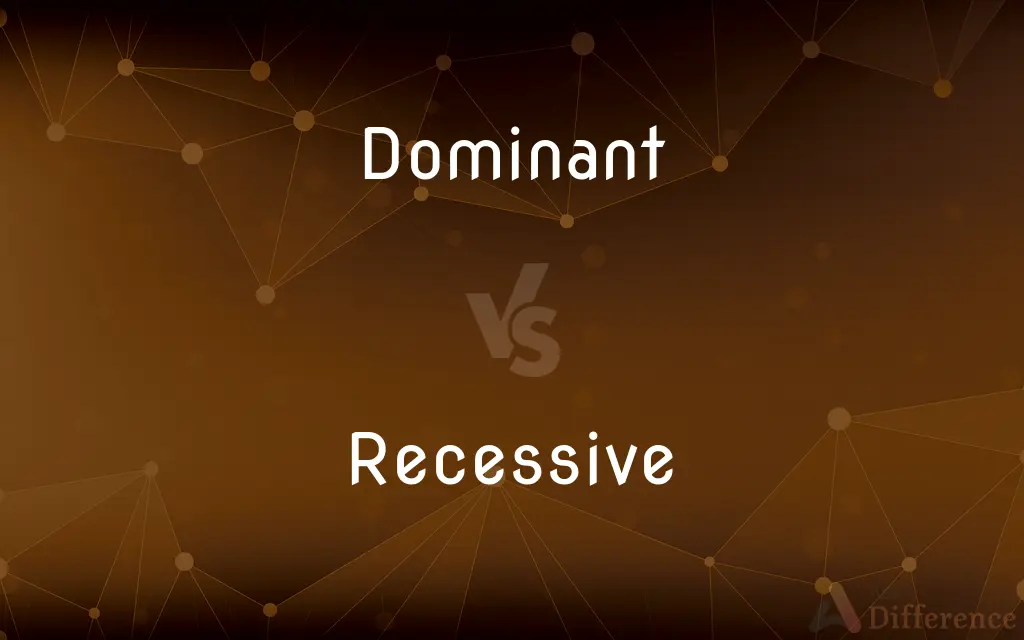Dominant vs. Recessive — What's the Difference?
By Tayyaba Rehman — Updated on September 22, 2023
Dominant traits mask the presence of recessive traits when paired together. A dominant allele shows its effect even if there's one copy, while a recessive allele shows only when two copies are present.

Difference Between Dominant and Recessive
Table of Contents
ADVERTISEMENT
Key Differences
Dominant and Recessive are terms that primarily revolve around the realm of genetics, particularly in explaining how traits are inherited from parent to offspring. A dominant trait is one that becomes visible even if only one of the two inherited alleles (gene variants) supports that trait. This means that even if an individual inherits different alleles, if one of them is dominant, that trait will be expressed. On the contrary, recessive traits require two copies of the recessive allele to be visible; if paired with a dominant allele, the recessive trait won't manifest.
Considering the human genotype, which consists of two alleles for each gene, one from each parent, the dominant allele takes precedence when paired with a recessive allele. For instance, in the case of eye color, brown is dominant over blue. So, an individual inheriting one brown (dominant) and one blue (recessive) allele will have brown eyes. Recessive traits, however, shine through only when no dominant allele is present to overshadow them. Using the same eye color example, blue eyes appear only when both inherited alleles advocate for it.
Beyond mere physical traits, Dominant and Recessive alleles play roles in determining the probability of offspring inheriting certain medical conditions. Some conditions are dominantly inherited, meaning just one copy of the causative allele from a parent can lead to the manifestation of the condition. Recessive conditions, however, necessitate both parents passing on the causative allele for the offspring to exhibit the condition.
Interestingly, while Dominant traits may seem more "powerful" due to their ability to mask recessive ones, they're not necessarily more common in populations. Recessive alleles can remain hidden in carriers (individuals who possess one recessive allele but don't show the trait) and can be passed down generations without being expressed, only to resurface when two carriers mate and both pass the recessive allele to their offspring.
Comparison Chart
Expression in Genotype
Manifests if one or two copies are present
Only appears if two copies are present
ADVERTISEMENT
Masking Ability
Can mask the effect of the recessive trait
Gets masked by dominant traits
Inherited Diseases
One affected allele can cause condition
Two affected alleles needed for condition
Population Frequency
Not necessarily more common
Can remain hidden in carriers
Example Trait
Brown eyes (in basic genetics)
Blue eyes (in basic genetics)
Compare with Definitions
Dominant
Leading or controlling a situation.
The team maintained a dominant position throughout the game.
Recessive
Not readily apparent or dominant.
Recessive genes can silently pass through generations.
Dominant
A trait that expresses itself even if only one allele supports it.
Brown eyes are dominant over blue eyes in basic genetic models.
Recessive
It yields or surrenders to a dominant factor.
In certain hybrids, the recessive trait might not be visible in the first generation.
Dominant
It can mask the presence of another trait.
The dominant gene for curly hair can overshadow the gene for straight hair.
Recessive
A trait that expresses only when two alleles support it.
Blue eyes manifest when both alleles are recessive for it.
Dominant
Most influential or widespread in a system.
English is a dominant language in global business.
Recessive
Requiring two copies to influence a condition or appearance.
Cystic fibrosis is caused by two copies of a recessive allele.
Dominant
Exercising the most power, control, or influence
The dominant nations during the Cold War.
Recessive
Tending to go backward or recede.
Dominant
Most abundant or conspicuous; predominant
"[The fireplaces'] shallow brick arches are a relief from the dominant squares and verticals of the windows and doors" (Stephen A. Kliment).
Recessive
(Genetics) Of, relating to, or designating an allele that does not produce a characteristic effect when present with a dominant allele.
Dominant
Higher; overlooking
Dominant hills.
Recessive
Of or relating to a trait that is expressed only when the determining allele is present in the homozygous condition.
Dominant
Tending to be stronger than its counterpart or used for the most important tasks or in the most pressing situations
Which is your dominant eye? Throw the ball with your dominant arm.
Recessive
A recessive allele or trait.
Dominant
(Genetics) Of, relating to, or being an allele that produces the same phenotypic effect in heterozygotes as in homozygotes.
Recessive
An organism having a recessive trait.
Dominant
(Ecology) Of, relating to, or being a species that is most characteristic of an ecological community and usually determines the presence, abundance, and type of other species.
Recessive
Going back; receding.
Dominant
(Music) Relating to or based on the fifth tone of a diatonic scale.
Recessive
(genetics) Able to be masked by a dominant allele or trait.
Dominant
(Genetics) A dominant allele or a trait produced by a dominant allele.
Recessive
(by extension) Not dominant; whose effect is masked by stronger effects.
Dominant
(Ecology) A dominant species.
Recessive
(genetics) A gene that is recessive.
Dominant
(Music) The fifth tone of a diatonic scale.
Recessive
Going back; receding.
Dominant
(music) The fifth major tone of a musical scale (five major steps above the note in question); thus G is the dominant of C, A of D, and so on.
Recessive
Not appearing in the phenotype unless both alleles of the organism have the same trait; - of genetic characteristics, or of the genes coding for such characteristics, in diploid organisms. Opposite of dominant; hemophilia is a recessive trait.
Dominant
(music) The triad built on the dominant tone.
Recessive
A genetic trait determined by a recessive{2} allele; a trait not appearing in the phenotype unless both chromosomes of the organism have the same allele; also, an allele which is recessive{2}.
Dominant
(genetics) A gene that is dominant.
Recessive
Of or pertaining to a recession
Dominant
A species or organism that is dominant.
Recessive
Of genes; producing its characteristic phenotype only when its allele is identical
Dominant
(BDSM) The dominating partner in sadomasochistic sexual activity.
Recessive
It remains hidden when paired with a dominant trait.
The recessive gene for albinism doesn't express if a normal pigmentation gene is present.
Dominant
Ruling; governing; prevailing
The dominant party controlled the government.
Dominant
Predominant, common, prevalent, of greatest importance.
The dominant plants of the Carboniferous were lycopods and early conifers.
Dominant
Preferred and used with greater dexterity than the other, as the right hand of a right-handed person or the left hand of a left-handed one.
Dominant
(medicine) Designating the follicle which will survive atresia and permit ovulation.
Dominant
(music) Being the dominant
Dominant seventh
Dominant
Ruling; governing; prevailing; controlling; predominant; as, the dominant party, church, spirit, power.
The member of a dominant race is, in his dealings with the subject race, seldom indeed fraudulent, . . . but imperious, insolent, and cruel.
Dominant
The fifth tone of the scale; thus G is the dominant of C, A of D, and so on.
Dominant
(music) the fifth note of the diatonic scale
Dominant
Exercising influence or control;
Television plays a dominant role in molding public opinion
The dominant partner in the marriage
Dominant
Of genes; producing the same phenotype whether its allele is identical or dissimilar
Dominant
A factor that prevails over others.
In a community of mixed predators, lions are the dominant species.
Common Curiosities
Can a person exhibit a recessive trait if they have one dominant and one recessive allele?
No, the dominant allele will mask the recessive trait's expression.
What determines if a trait is dominant or recessive?
The inheritance pattern of genes, where a dominant allele expresses even with one copy and a recessive allele needs two copies to manifest, determines this.
Can two parents with recessive traits produce an offspring with a dominant trait?
No, if both parents carry two recessive alleles, the offspring will inherit the recessive trait.
Are dominant traits always more common than recessive ones in populations?
Not necessarily; while dominant traits express more readily, they aren't always more frequent in a population.
What is a carrier in the context of recessive traits?
A carrier possesses one recessive allele but doesn't exhibit the recessive trait, as the other allele is dominant.
Share Your Discovery

Previous Comparison
Technology vs. Engineering
Next Comparison
Adjacent vs. NonadjacentAuthor Spotlight
Written by
Tayyaba RehmanTayyaba Rehman is a distinguished writer, currently serving as a primary contributor to askdifference.com. As a researcher in semantics and etymology, Tayyaba's passion for the complexity of languages and their distinctions has found a perfect home on the platform. Tayyaba delves into the intricacies of language, distinguishing between commonly confused words and phrases, thereby providing clarity for readers worldwide.














































